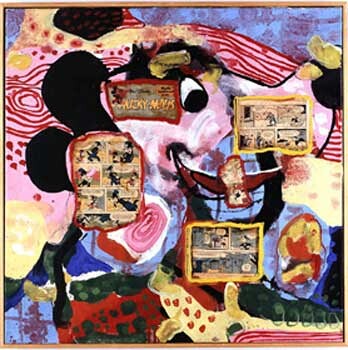Opening: 8 March 2007, 7 pm
Exhibition: 9 March – 29 April 2007
Academy of Fine Arts Vienna
Schillerplatz 3 | Aula 1010 Vienna
Phone ( 43 1) 588 16-0 |
http://www.akbild.ac.at
IMAGE: Uwe Lausen: “Mickey Mouse”, 1964-66, copyright Courtesy Contemporary Fine Arts | Galerie Michael Haas, Berlin, Foto: Jochen Littkemann
“My words, my half sentences and half truths, my slogans, my headings: can you read them, can you understand them, do they tell you anything?” asked Uwe Lausen in one of his numerous texts (»Überschriften« typescript, private collection). This has taken quite some time though Lausen belonged to the Munich group SPUR and was supported by galleries such as Friedrich & Dahlem. After his work had been more or less forgotten after his death, it was only in the eighties that painters such as Albert Oehlen became interested in it. Today, Lausen’s work seems to tap the pulse of the age for many people. His later paintings may be seen as reference points for Kai Althoff, for example. And Daniel Richter actually incorporated Lausen’s paintings into one of his recent exhibitions. The presentation at the Academy of Fine Arts Vienna “Gehirnschaukel [Brain Swing]. Transitions in Uwe Lausen’s Work” is the first solo show since 1984.
Uwe Lausen was born in Stuttgart in 1941. He began to study law and philosophy but left the university after only a few months. This decision may have been caused by his beginning friendship with the artists of the group SPUR in Munich which was part of the Situationist International. Having a good knowledge of French, Lausen stayed in close touch with Guy Debord. His first paintings reveal the influence of the COBRA group, of Carel Appel and Asger Jorn. Despite their gestural character, the pastose works are clearly figurative.
The exhibition at the Academy focuses on Lausen’s experimental phase and years of quest from 1963 to 1965. The presented 36 paintings illustrate how the artist’s expressionist gesture was curbed by a broken ornamentation modeled on Hundertwasser’s works. Uwe Lausen remained fascinated by the human body, its pleasures and pains and turned to Francis Bacon for inspiration. Yet, relying on tricks which would be categorized as dirty along the rules of traditional painting, he avoided balanced compositions. Abstract biomorphic forms clash with realistically painted details. As in illustrations of old street ballads, the canvases are divided into rectangular windows. Unexpected abstract ornaments remind us of cancellation postmarks. Lausen also glued pictures from newspapers onto his paintings. With these techniques that unfold a field of tension between achievement and failure, Lausen developed a repertoire people can still profit from today.
From 1965 on, the artist rejected any free gestural approach. His pictures, which deal with war, terror, and violence, reveal a pop-art spirit and a graphic Hard Edge tenor. Towards the end of 1969, Lausen ceased to paint and started dedicating himself to nothing but musical experiments. He committed suicide on 14 September 1970.
Text Stephan Schmidt-Wulffen



